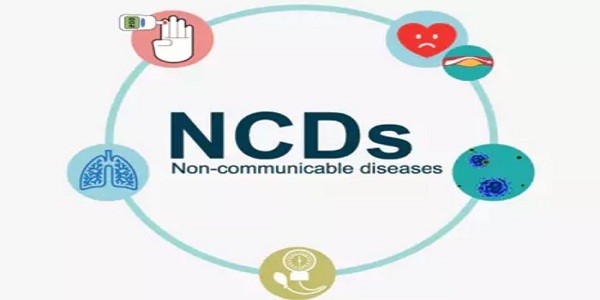Non-communicable diseases (NCDs), often known as chronic diseases, are non-transmissible illnesses of often long-term or long duration. They include heart diseases and stroke (cardiovascular diseases – CVDs), diabetes, chronic respiratory diseases, cancer and mental health conditions just to mention a few.
They are driven primarily by a combination of genetic, physiological, environmental, and behavioural factors that have been shown to begin during the period of conception through birth, childhood and adolescence, and bring about negative health outcomes in adulthood.
Indeed, many factors, both modifiable and non-modifiable, have been attributed to the rise of NCDs. These include lifestyle changes, rapid urbanization and population increase, rising life expectancy, and epidemiological and nutritional transition.
Specific risk factors such as poor diet, tobacco use, high salt consumption, harmful use of alcohol, physical inactivity and air pollution, leading to obesity, hypertension, diabetes and dyslipidaemia, have all been linked to NCDs. Essentially, it is becoming more evident that most, if not all, of the causes of NCDs are nutrition or diet-related (N-RNCDs).
While NCDs were assumed to be more prominent in developed countries, the majority of the global increase in these diseases is occurring in low- and middle-income countries (LMICs) with Sub-Saharan Africa experiencing the highest burden over the last two decades.
Deaths from NCDs have either paralleled or overtaken that from communicable (infectious) diseases and in many LMICs has resulted in what is described as the double burden of disease. It is not surprising that the rising spate of NCDs in LMICs has been described as an emerging global crisis.
Over the last two decades, there has been a growing body of evidence that in-utero, infant and young child undernutrition is directly linked to vulnerability to adult N-RNCD. This suggests that health and nutrition interventions in the 1,000 days period, or from conception to two years of age, can provide additional benefits beyond the immediate term in the form of reductions in N-RNCD incidence and mortality.
Indeed, poor foods, diet and nutritional status, including overweight and obesity, which are also associated with elevated blood pressure, cholesterol and resistance to the action of insulin (elevating blood glucose) are not only risk factors for NCDs, but major causes of illness themselves.
Unhealthy diets and a lack of physical activity may show up in people as raised blood pressure, increased blood glucose, elevated blood lipids and obesity. These are called metabolic risk factors and can lead to CVDs, the leading NCD in terms of premature deaths.
Over the last few decades, the leading causes of death in our settings have been attributed to CVDs (Hypertension, stroke, etc), cancer, diabetes, and chronic respiratory illnesses, which have all remained among the top ten causes of death, and contributing to the risk of dying prematurely between the ages of 30 and 70.
Although CVDs and diabetes contribute to the largest national NCD burden in Ghana, some other conditions hitherto, unrecognised as NCDs (including asthma, neonatal disorders, kidney disease, osteoporosis, epilepsy and other mental disorders) are coming under the radar of emerging NCDs.
The burden of NCDs is projected to increase due to ageing, rapid urbanization, and unhealthy lifestyle. The prevalent rates of major risk factors of NCDs such as overweight, physical inactivity, poor diet and the abnormal use/consumption of alcohol and sugar sweetened beverages (SSBs) in Ghana have also been increasing over the years.
The state of NCDs in Ghana can only be described as sorry and no region or zone or population group is spared. However, very little seems to be done to stem its tide. This has been described as worrying, given the scarcity of specific programmes and policies needed to tackle them in the country.
NCDs have a significant impact on the livelihoods of communities, and those in the Savannah belt of Ghana are no exception. NCDs disproportionately affect impoverished communities, pushing individuals and households deeper into poverty, and posing long-term psychosocial problems. Living with a chronic condition is difficult because it interferes with physical, mental, and social functioning, lowering a person’s quality of life.
Additionally, the existence of multiple chronic illnesses in the same person has far-reaching consequences on healthcare costs and utilization. The Savanna zone in Ghana represents a traditional example of a nutrition-poor environment, with little overlap between under- and over-nutrition: high rates of stunting and low prevalence of overweight among children.
In Ghana, however, child and maternal overweight overlap with stunting and low birth weight, and prevalence of overnutrition is beginning to overtake undernutrition in some groups. The prevalence of hypertension and female and child overweight is high and climbing quickly in this region/zone; this growth, combined with high rates of low birth weight, stunting, and increased calorie availability through the overconsumption of refined carbohydrates and SSBs, may lead to a significant increase in N-RNCDs in this region over the next decade.
In the Savanna belt of Ghana, many of the risk factors for NCDs can be recognised. Tobacco smoking, abuse of alcohol/drugs and over-consumption of SSBs among adolescents and adults are not uncommon. The consumption of poor/unhealthy diets and physical inactivity has become the bane of many residents, and as urbanisation occurs, other important conditions also considered as NCDs, such as injuries (especially from motor bikes) and mental illnesses are on the ascendancy.
NCDs are killing and maiming many people in the savanna belt, and having a toll on their health and for that matter their livelihoods. There seem to be no end in sight to the upsurge of this menace and that is most worrying. The most important question to ask at this point is “What are we doing about this?”
Concerned, troubled and alarmed by the soaring health costs and deaths linked to diet-related NCDs, a group of Public Health Advocates known as the Advocating for Health (A4H) Coalition comprising Academia, Civil Society Organization, Public Health Associations and Nutrition/Dietetic Professional Group are currently advocating for the creation of a favourable environment and stakeholder buy-in for food-related fiscal policies in Ghana.
Source: Paul Armah Aryee
Associate Professor of Public Health Nutrition, UDS
Member, GAND, M3T of HD4HL












